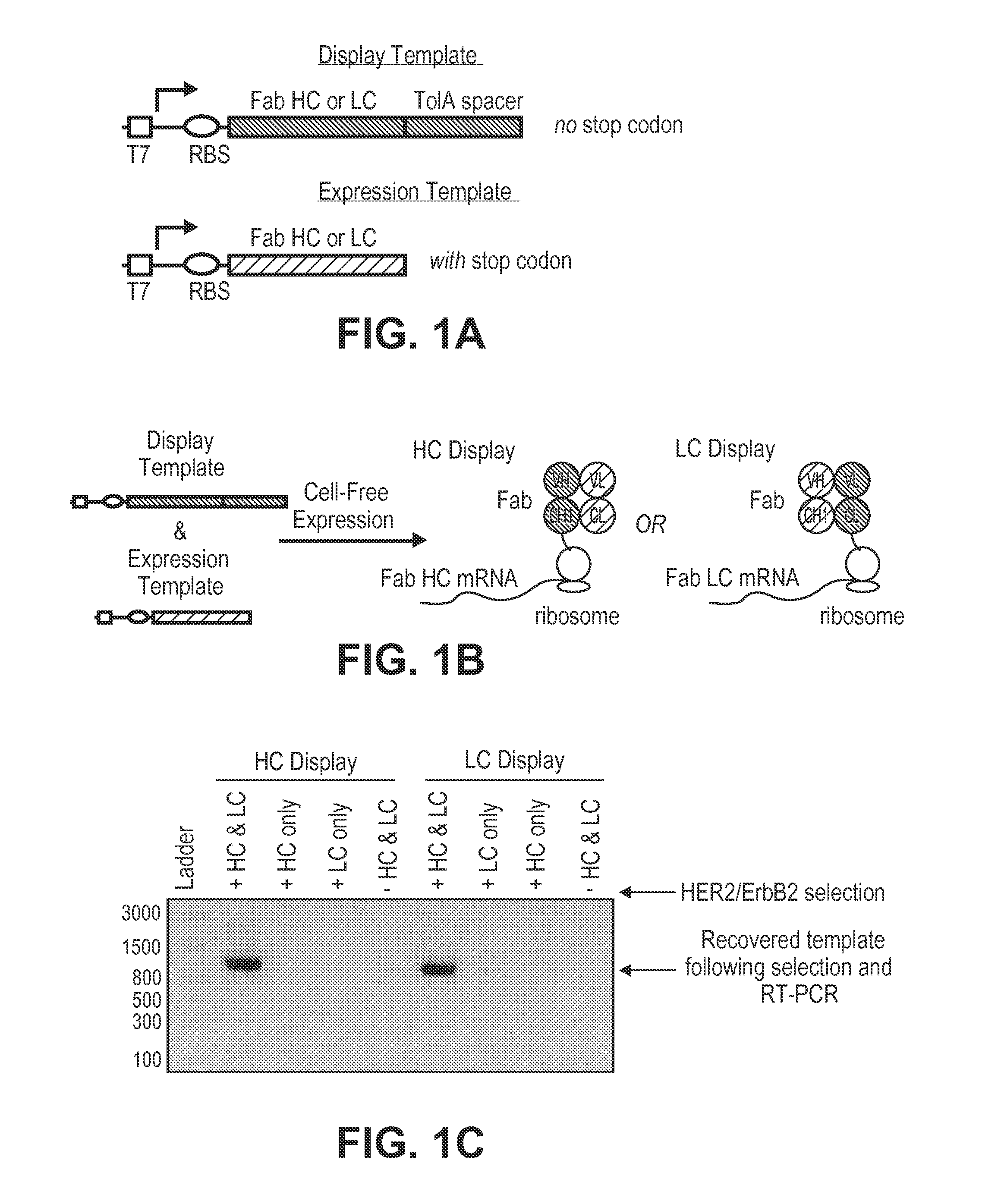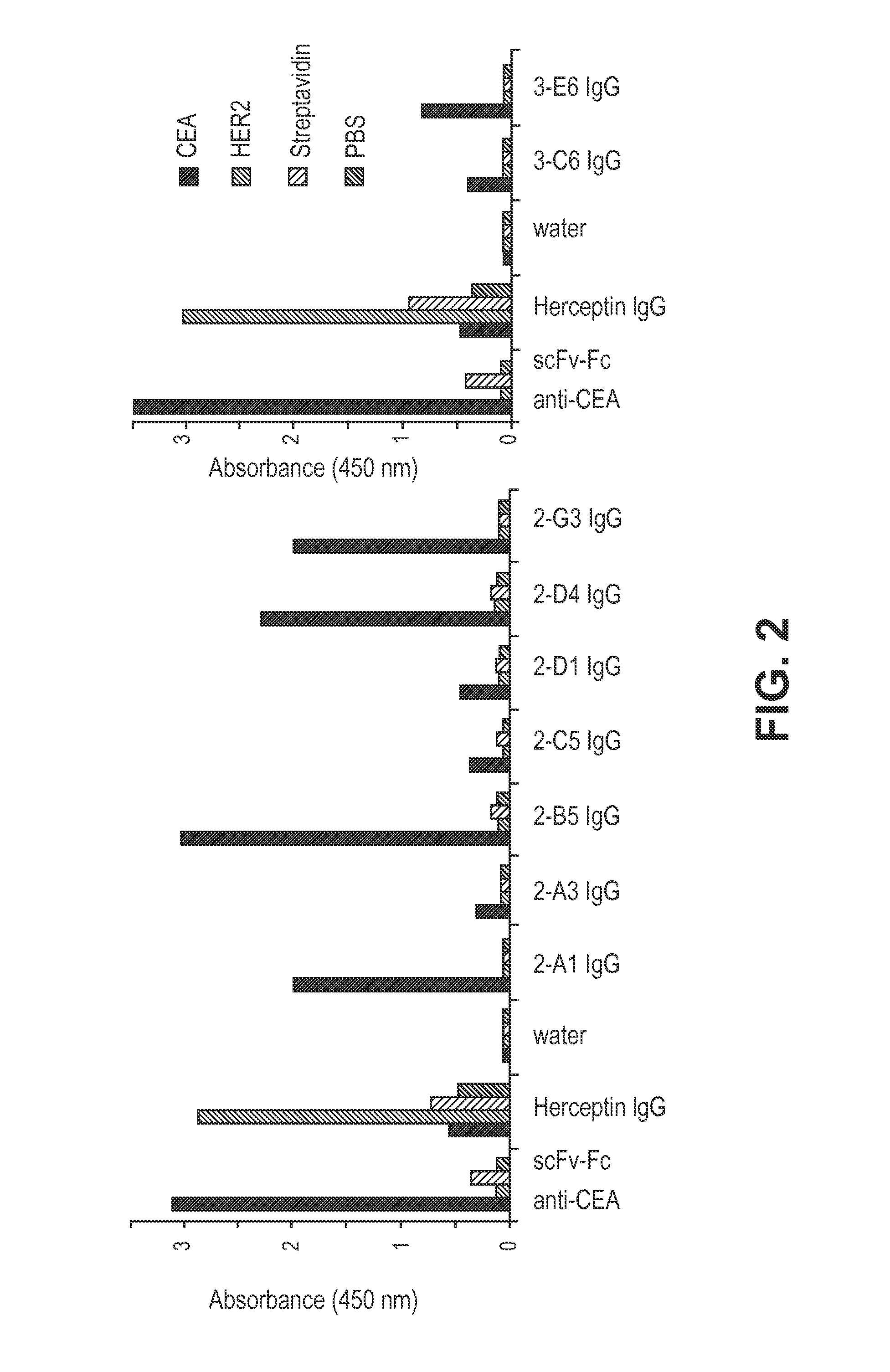Selection of fab fragments using ribosomal display technology
a ribosomal display and fab fragment technology, applied in the field of selecting fab fragments using ribosomal display technology, can solve the problem of too slow kinetics of chain association
- Summary
- Abstract
- Description
- Claims
- Application Information
AI Technical Summary
Benefits of technology
Problems solved by technology
Method used
Image
Examples
example 1
Fab Heavy Chain and Light Chain Display
[0149]This example illustrates a method for selecting a heterodimeric Fab domain by ribosome display using two templates: (1) a display template containing the Fab heavy chain (HC) fused to a TolA spacer without a stop codon, and (2) a complementary expression template containing the Fab light chain (LC) with a stop codon (FIG. 1A). The lack of a stop codon at the end of the display template forces stalling of the ribosome at the end of the HC mRNA transcript enabling formation of the ternary protein-ribosome-mRNA complex. The TolA spacer is a standard unstructured domain used in ribosome display which allows the nascent Fab HC to project from the exit tunnel and fold outside of the ribosome. The LC expression template contains a stop codon at the end of the transcript and lacks the TolA spacer since it is not intended to be displayed directly from the ribosome nor linked to its own mRNA transcript. Instead, co-expression of the LC enables hete...
example 2
DNA Library Design for Fab Fragments
[0153]The Fab HC library was built onto the trastuzumab Fab variable heavy chain (HC) scaffold. The trastuzumab scaffold was cloned into the NcoI and HindIII sites of a pUC ribosome display vector (pRDV) containing the TolA spacer (GenBank Accession No. AY327136.1). The Fab HC only library design was based on the published library (Lee et al., JMB, 340:1073-1093 (2004)) using the same limited diversity in CDRs H1 and H2. CDR H3 was restricted to a single loop length of 11 amino acids and 8 residues were randomized using NNK codons. The library was constructed using overlapping PCR as described below.
[0154]For the Fab HC DNA library, synthetic oligonucleotides (Table 2) containing degenerate codons were dissolved to generate 100 μM stocks. T7B and TolAk primers have been previously reported (Dreier and Plückthun, Methods Mol. Biol., 687: 283-306 (2011)). Primer sets were mixed to give similar degeneracy as Lee et al. H1a For and H1b For primers wer...
example 3
Identifying Fab Fragments Using Ribosomal Display and the PURE System
[0155]A. Selection of Fab Fragments in PURE System
[0156]This example illustrates the method of selecting Fab fragments from a Fab library, wherein the heavy chain library is generated from a DNA library and a reconstituted ribosome system (e.g., PURE system). The method includes selecting Fab fragments that specifically bind to a target antigen by using ribosomal display.
[0157]An aliquot of the Fab HC library was purified by gel extraction from a 1% agarose gel before the selection. The first round of selection was performing using coupled transcription / translation reactions (10×25 μL each) were each performed using 7.5 μg pre-purified variable light chain protein and 248 ng of the DNA library. For subsequent rounds, only 2 reactions were performed for the plus target antigen set (+Ag; 25 μL each) and 2 reactions for the negative target antigen set (−Ag; 25 μL each) using between 130-230 ng DNA for each reaction.
[0...
PUM
| Property | Measurement | Unit |
|---|---|---|
| concentration | aaaaa | aaaaa |
| concentration | aaaaa | aaaaa |
| concentration | aaaaa | aaaaa |
Abstract
Description
Claims
Application Information
 Login to View More
Login to View More - R&D
- Intellectual Property
- Life Sciences
- Materials
- Tech Scout
- Unparalleled Data Quality
- Higher Quality Content
- 60% Fewer Hallucinations
Browse by: Latest US Patents, China's latest patents, Technical Efficacy Thesaurus, Application Domain, Technology Topic, Popular Technical Reports.
© 2025 PatSnap. All rights reserved.Legal|Privacy policy|Modern Slavery Act Transparency Statement|Sitemap|About US| Contact US: help@patsnap.com



